As a nerd with a long-standing interest in science fiction, and a lazy person with a long-standing interest in television, it may seem surprising that I never watched Doctor Who. I was certainly aware of the iconic show, but, like other lauded series (e.g., Buffy the Vampire Slayer (another recently-rectified mistake, thanks to Netflix)), I had let it pass me by. My father would watch an occasional episode in the early 1980s, mostly after I had left for college, but I never sat down with him to watch an episode.
I suspect that the combination of two things dampened my interest: first, the sheer magnitude of the task was daunting. Twenty-six seasons of the show, albeit shorter seasons than a typical U.S. television series (though I didn't know this at the time), would make for a time-consuming and likely prohibitively expensive education. As with many serials, later episodes build on the past to create a comprehensive universe. Jumping in in the middle seemed like a recipe for confusion.
Second, the Doctors of the 1970s and 1980s, the ones I would see in glimpses on PBS and in advertisements, seemed all too...well, alien in their British eccentricity. The wild-haired Tom Baker, for example, with his odd manner of dress and queer grin, made me think of Gene Wilder's portrayal of Willy Wonka, and I didn't warm to the prospect of journeying through space and time with such an oddball.
As time passed, however, and virtual friends would sing the praises of the show, eagerly anticipating new episodes and new seasons, I realized I needed to see what the fuss was about. Doing a little research, it seemed as though the 2005 revival of the series, which had been cancelled in 1989, was a logical stepping-off point. Restarting the series meant that the writers needed to draw in a new audience that was not aware of the conventions developed in the earlier long history of the show. I could start anew, with only 6 1/2 short seasons plus a handful of specials to catch up on. The three actors who have played the Doctor in the revival (Christopher Eccleston, David Tennant, and Matt Smith) each have their own odd sartorial style, but look less like stereotypical British eccentrics than earlier Doctors, another point in favor of starting in '05.
I did a small amount of poking about on the Aetherwebs to see if I needed to know more of the show's history to understand the new episodes, and I listened to the first episode of the Dirty WHOers podcast, with Second Life alumnae/i Fuschia Begonia, Oolong Sputnik, Terry Lightfoot, and Mr. Sen, but otherwise went into the project cold.
I'll get the suspense out of the way: I liked Season 1 very much and have already queued up Season 2. Eccleston's Ninth Doctor was an intriguing character, seemingly blasé and carefree at times and passionate and angry at others (and I loved how he would frequently say "Fantastic!" in that accent of his). I was disappointed that he didn't stay on for more than one season. While the conceit of the show - the Doctor doesn't die but regenerates into a different form - allows for smooth transitions from actor to actor, one season of 13 episodes doesn't seem long enough to get to know this Doctor.
The other part of the show that leaves me uneasy is the reliance on the deus ex machina. To be fair, all fiction does this to some extent for dramatic effect, and TV dramas are especially prone to the use of the device, in part because of the need to fit the plot into a tight time constraint and in part because of lazy writing. Yet in Doctor Who the rules seem to be made up as they go along. Maybe these rules were laid down in the earlier incarnation of the show, but too often it seemed as though an episode would get to minute 42 and the writers would need to get the Doctor out of a tight spot, so they'd introduce a new feature of the TARDIS, or have the Doctor mumble something about time healing itself. (In fairness, some of the best episodes set up the important plot device earlier in the episode or earlier in the season. For example, in the season finale, the "heart of the TARDIS" plays an important role, but an earlier episode introduced the concept.)
The Doctor travels with one or more companions - that's one of the few factoids I knew going in. The companion serves as least two dramatic purposes: first, she or he is the audience's entry into the Doctor's world. We learn about the TARDIS, or the Time Lords, or events on Earth millennia in the future through the device of the Doctor explaining things to his companion. Second, the companion humanizes the Doctor, providing him someone to care for, or yell at, or otherwise be involved with. (Third, it's hard to write dialogue without two characters. The companion makes life easier for the writers.)
I have mixed feelings about Rose, the Doctor's companion for Series 1. (A certain Pixie has no mixed feelings - both thumbs down.) She's frequently annoying, dithering about her boyfriend, Micky, squabbling with her (truly annoying) mother, and crying a lot. On the other hand, she grows in emotional maturity a great deal over the season, from running way from plastic men in "Rose" to figuring out how to override the Doctor's instructions and operate the TARDIS in "The Parting of the Ways."
I'd prefer less emphasis placed on stock villains - this season had two episodes with Daleks, with more promised in subsequent seasons - and, for a guy who has all of space at his disposal, he spends an inordinate amount of time on Earth (budget control for the producers, I realize, but still...) Nonetheless, I can see why the series has such a devoted set of fans.
Wednesday, November 28, 2012
Saturday, November 24, 2012
Taxes and Spending, Part 3
Some of the increase is in the budgets of various Federal agencies, but, to be honest, the rate of growth of my agency doesn't seem to have changed much between the Bush and Obama years, with budget growth averaging between 6 and 9% annually for all but two of those years (a 13% increase in 2010 and no increase in 2011). This is substantially faster than the rate of inflation over that time, and it reflects poorly on the willingness of Congress to restrain the growth of discretionary spending, but it's a bipartisan shame. (As an aside, I think my agency does useful work - maybe not important, in the grand scheme of things, but useful and probably well worth the expense ($312 million in fiscal 2012, much of it from industry fees). The problem is that increasing the size of the agency every year - and the agency's request for fiscal 2013 was for an additional 10 employees - is that the law of diminishing marginal returns kicks in and we end up working increasingly trivial matters. Thus, although I'd be happy to defend the agency as an entity, it's much harder to defend the incremental increases in budget.)
I think what came before should be fairly uncontroversial. Now comes the tougher sell. First, the problem is about to become worse, both because of the aging population (requiring greater Social Security and Medicare spending) and, more imminently, because historically-low interest rates won't last forever, and when interest rates increase the cost of financing the $16 trillion (and growing) national debit will increase proportionately. We can't tax our way back to fiscal health. President Obama's proposal would raise about $50 billion annually in new income taxes from wealthy people, and additional $31 billion in estate and gift tax increases, according to the Washington Post. The President has other proposals that would bring the total revenue increase to around $160 billion annually. That's a nice start, but it's not cutting the deficit in a meaningful way.
Only two things will make a substantial difference in the deficit: increase taxes substantially, across the board, or decrease spending substantially, across the board. (Or some combination of the two.) The first solution is what I'll refer to as European. It envisions are large and permanent welfare state that is financed through a very broad tax base, such as the VAT. It's true that top income tax rates are higher in most of Europe than in the U.S., although corporate tax rates are generally lower, but the real action comes not from taxing the small number of wealthy people but through taxing a large number of middle-class people, and that's what a VAT does for you.
Alternatively, we can cut spending substantially. The U.S. spends vastly more on defense than any other country in the world - I saw a claim that the U.S. spends as much as the next 20 or so countries combined. National security hawks dislike the idea of cutting defense spending to pay for social spending, but that's a possibility. Cutting discretionary spending back to the levels of, say, 2008 and then limiting growth to the rate of inflation would be a big help. It's not as though we were hurting for federal spending in '08. That would require about a 22% cut in my agency's budget, which would be painful for everyone if done at once, but phasing in that kind of a cut over a few years would help.
My purpose in presenting a tedious series of numbers is to try to persuade the reader that the U.S. has a big fiscal problem on its hands. One can be okay with raising taxes broadly, at the cost of some economic growth and lower disposable income for the middle class, or one can come up with spending cuts that are palatable, or some combination of the two, but it's simply naive to think that raising taxes on the "rich" is a complete solution.
I think what came before should be fairly uncontroversial. Now comes the tougher sell. First, the problem is about to become worse, both because of the aging population (requiring greater Social Security and Medicare spending) and, more imminently, because historically-low interest rates won't last forever, and when interest rates increase the cost of financing the $16 trillion (and growing) national debit will increase proportionately. We can't tax our way back to fiscal health. President Obama's proposal would raise about $50 billion annually in new income taxes from wealthy people, and additional $31 billion in estate and gift tax increases, according to the Washington Post. The President has other proposals that would bring the total revenue increase to around $160 billion annually. That's a nice start, but it's not cutting the deficit in a meaningful way.
Only two things will make a substantial difference in the deficit: increase taxes substantially, across the board, or decrease spending substantially, across the board. (Or some combination of the two.) The first solution is what I'll refer to as European. It envisions are large and permanent welfare state that is financed through a very broad tax base, such as the VAT. It's true that top income tax rates are higher in most of Europe than in the U.S., although corporate tax rates are generally lower, but the real action comes not from taxing the small number of wealthy people but through taxing a large number of middle-class people, and that's what a VAT does for you.
Alternatively, we can cut spending substantially. The U.S. spends vastly more on defense than any other country in the world - I saw a claim that the U.S. spends as much as the next 20 or so countries combined. National security hawks dislike the idea of cutting defense spending to pay for social spending, but that's a possibility. Cutting discretionary spending back to the levels of, say, 2008 and then limiting growth to the rate of inflation would be a big help. It's not as though we were hurting for federal spending in '08. That would require about a 22% cut in my agency's budget, which would be painful for everyone if done at once, but phasing in that kind of a cut over a few years would help.
My purpose in presenting a tedious series of numbers is to try to persuade the reader that the U.S. has a big fiscal problem on its hands. One can be okay with raising taxes broadly, at the cost of some economic growth and lower disposable income for the middle class, or one can come up with spending cuts that are palatable, or some combination of the two, but it's simply naive to think that raising taxes on the "rich" is a complete solution.
Thursday, November 22, 2012
Taxes and Spending, Part 2
See Part 1 here.
I don't think I'm going out on a limb or being partisan when I say that the current fiscal situation is not sustainable. We can't keep running trillion-dollar deficits indefinitely. I think it's only slightly more controversial to say that we can't sustain this level of spending solely through higher income taxes on the wealthy.
To put the last few years in perspective, the Congressional Budget Office has a chart of the U.S. government's surplus or deficit as a fraction of GDP (so we don't have to worry about inflation). Excluding Social Security - currently in a small surplus, and shortly expected to fall into a small but growing deficit - the numbers since 2000 are:
An optimist would say that the situation has improved since 2009, while a pessimist would say that things are still on an unsustainable path.
The 2000 figure was the result of President Clinton and the Republican-controlled Congress's belt-tightening of the late 1990s, combined with a roaring economy, leading to higher tax revenue. One could say that the 2001 figure was also largely driven by President Clinton and the same Republican Congress. 2002 through 2007 reflected two big items: lower tax receipts because of the 2001 (and 2003) Bush-era tax cuts, and substantially higher defense and homeland security expenditures because of post-9/11 domestic spending and the wars in Iraq and Afghanistan. By the middle of the decade, war spending was down a little, I believe, but tax receipts were rebounding.
Then the housing/financial crisis hit. Some of that is reflected in 2008, but much of it was reflected in 2009, including the $800 billion stimulus bill, the GM and Chrysler bailouts, and a second round of bank bailouts. (Banks largely repaid their loans, resulting in higher government receipts at some point. The auto bailouts are a story for another day.) Tax receipts were down substantially because of the recession, and counter-cyclical spending, such as spending on unemployment benefits and food stamps, went up, resulting in a post-World War II record deficit. Again, none of this takes a position on whether the 2008 and 2009 spending was a good or bad thing, necessary or unnecessary; these are just numbers.
Since 2009, with the economy officially out of recession but growing slowly, the U.S. has continued to run trillion-dollar deficits although, as the chart above shows, these deficits reflect a declining share of a (growing) economy. War spending continues to decline as well, and tax receipts are up slightly as more people are working.
What I conclude from this is that we don't have a revenue problem, we have a spending problem. Excluding the "crisis" years of 2008 and 2009, we've gone from the horrible deficit spending of the Bush years to even more abysmal levels: from 3 to 5% of GDP to more than 9% of GDP. The Bush tax cuts aren't to blame for this, as those tax cuts were in place during the Bush years as well. War spending isn't the issue, because war spending has declined. Instead, much of the "emergency" spending that took place in what was arguably a time of crisis has become the new normal. Some of this is increased spending on social services - for example, the number of people on food stamps has gone up substantially, and Congress keeps passing extensions of unemployment benefits.
In the last part, I make the argument that maintaining the current level of spending is going to require substantial tax increases on everyone, not just the rich, or, alternatively, maintaining the current tax level on everyone but the rich will require substantial spending cuts.
I don't think I'm going out on a limb or being partisan when I say that the current fiscal situation is not sustainable. We can't keep running trillion-dollar deficits indefinitely. I think it's only slightly more controversial to say that we can't sustain this level of spending solely through higher income taxes on the wealthy.
To put the last few years in perspective, the Congressional Budget Office has a chart of the U.S. government's surplus or deficit as a fraction of GDP (so we don't have to worry about inflation). Excluding Social Security - currently in a small surplus, and shortly expected to fall into a small but growing deficit - the numbers since 2000 are:
- 2000 0.9%
- 2001 -0.3
- 2002 -3.0
- 2003 -4.9
- 2004 -4.9
- 2005 -4.0
- 2006 -3.3
- 2007 -2.5
- 2008 -4.5
- 2009 -11.1
- 2010 -9.5
- 2011 -9.1
An optimist would say that the situation has improved since 2009, while a pessimist would say that things are still on an unsustainable path.
The 2000 figure was the result of President Clinton and the Republican-controlled Congress's belt-tightening of the late 1990s, combined with a roaring economy, leading to higher tax revenue. One could say that the 2001 figure was also largely driven by President Clinton and the same Republican Congress. 2002 through 2007 reflected two big items: lower tax receipts because of the 2001 (and 2003) Bush-era tax cuts, and substantially higher defense and homeland security expenditures because of post-9/11 domestic spending and the wars in Iraq and Afghanistan. By the middle of the decade, war spending was down a little, I believe, but tax receipts were rebounding.
Then the housing/financial crisis hit. Some of that is reflected in 2008, but much of it was reflected in 2009, including the $800 billion stimulus bill, the GM and Chrysler bailouts, and a second round of bank bailouts. (Banks largely repaid their loans, resulting in higher government receipts at some point. The auto bailouts are a story for another day.) Tax receipts were down substantially because of the recession, and counter-cyclical spending, such as spending on unemployment benefits and food stamps, went up, resulting in a post-World War II record deficit. Again, none of this takes a position on whether the 2008 and 2009 spending was a good or bad thing, necessary or unnecessary; these are just numbers.
Since 2009, with the economy officially out of recession but growing slowly, the U.S. has continued to run trillion-dollar deficits although, as the chart above shows, these deficits reflect a declining share of a (growing) economy. War spending continues to decline as well, and tax receipts are up slightly as more people are working.
What I conclude from this is that we don't have a revenue problem, we have a spending problem. Excluding the "crisis" years of 2008 and 2009, we've gone from the horrible deficit spending of the Bush years to even more abysmal levels: from 3 to 5% of GDP to more than 9% of GDP. The Bush tax cuts aren't to blame for this, as those tax cuts were in place during the Bush years as well. War spending isn't the issue, because war spending has declined. Instead, much of the "emergency" spending that took place in what was arguably a time of crisis has become the new normal. Some of this is increased spending on social services - for example, the number of people on food stamps has gone up substantially, and Congress keeps passing extensions of unemployment benefits.
In the last part, I make the argument that maintaining the current level of spending is going to require substantial tax increases on everyone, not just the rich, or, alternatively, maintaining the current tax level on everyone but the rich will require substantial spending cuts.
Tuesday, November 20, 2012
Aether Salon - Literature
This month, the Aether Salon presented Dame Kghia Gherardi, who spoke on the origins of Steampunk Literature.
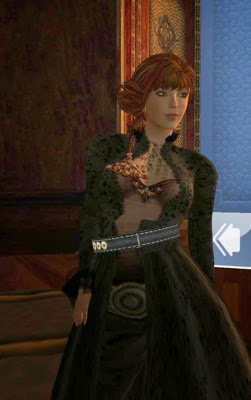
Dame Kghia Gherardi
Dame Kghia noted that author KW Jeter coined the term in 1987, describing the genre as "Victorian fantasies." She continued:
"Proto-Steampunk" novels:
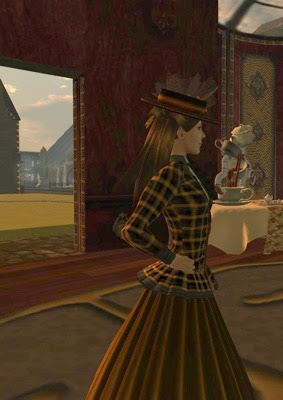
Miss Bookworm Hienrichs

L to R: Mr. Emerson Lighthouse, Miss Violet Solano, Miss Garnet Psaltery, Miss Tephi Zepp, Miss Robin Ishmere, Sir JJ Drinkwater, Miss Hysshia ap Suolla an Isala

L to R: Mr. Guisborn, Miss Sidonie Ancelin, me, Mr. Kelso Uxlay
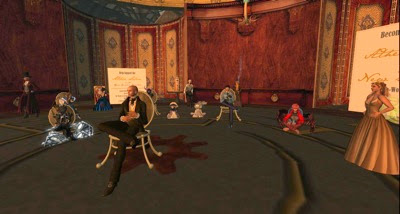
L to R, from the foreground chair: Mr. Simeon Beresford, Miss Solace Fairlady, Miss Stereo Nacht, Mr. Kelso Uxlay, Miss Polly Ellsmere, Mr. Linus Lacome, Mr. Sebastian Nevermas, Mr. Satu Moreau, Miss Cassie Eldemas
Dame Kghia's talk made it clear that I - along with much of the audience, it appeared - have some reading to do!

Dame Kghia Gherardi
Dame Kghia noted that author KW Jeter coined the term in 1987, describing the genre as "Victorian fantasies." She continued:
From artist John Coulthart, we get this explanation: STEAMPUNK = Mad Scientist Inventor [invention (steam x airship or metal man/baroque stylings) x (pseudo) Victorian setting] + progressive or reactionary politics x adventure plot….
Steampunk has always been first and foremost a literary genre, or [at] least a sub-genre of science fiction and fantasy that includes social or technological aspects of the 19th century (the steam) usually with some deconstruction of, reimagining of, rebellion against part of it (the punk)….
Here is perhaps one of my favorites from author Beth Bernobich: Steampunk is...a mood (fog-laden streets lined with cobblestones); a theme (a world standing on the edge between one age and the next), a tech level (horses and automobiles, clockwork creations, goggles and steam engines, and aircraft rising toward the stars), and more than a bit of madness….
Other definitions:
Steampunk is...the love child of Hot Topic and a BBC costume drama.
~Gail Carriger, author of The Parasol Protectorate series
Steampunk is what happens when goths discover brown. ~ Jess Nevins, author of Encyclopedia of Fantastic Victoriana
That said, I think Jeff VanderMeer and SJ Chambers has given us perhaps the most workable framework for steampunk literature today. And if you are trying to decide of a work falls into this category, this definition may help. First, it’s simultaneously retro and forward-looking in nature. Second, it evokes a sense of adventure and discovery. Third, it embraces divergent and extinct technologies as a way of talking about the future.Dame Kghia provided a list of novels in the genre, under various categories:
"Proto-Steampunk" novels:
- Mary Shelley, Frankenstein (1818)
- Jules Verne, 20,000 Leagues Under the Sea (1870) and The Steam House (188)
- HG Wells, The Time Machine (1895) and Men Like Gods (1923)
- Edward Ellis, The Huge Hunter of the Steam Man of the Prairies (1865)
- Henry Eaton, Frank Reade and His Steam Man of the Plain (1876)
- Luis Senarens, Frank Reade, Jr. and His Steam Wonder (1879)
- Ronald Clark, Queen Victoria's Bomb (1969)
- Michael Moorcock, The Warlord of the Air (1971)
- Harry Harrison, A Transatlantic Tunnel, Hurrah! (1972)
- Tim Powers, The Anubis Gates (1983)
- KW Jeter, Infernal Devices (1987)
- Peter J Blaylock, Lord Kelvin's Machine (1992)
- William Gibson and Bruce Sterling, The Difference Engine (1990)
- Neal Stephenson, The Diamond Age: Or, a Lady's Illustrated Primer (1995)
- Philip Pullman, The Golden Compass (1995)
- Paul de Filippo, The Steampunk Trilogy (1995)
- Gail Carriger, The Parasol Protectorate
- Cherie Priest, Boneshaker
- Kim Newman, Anno Dracula
- Clay Griffith, The Greyfriar
- Lilith Saintcrow, The Iron Wyrm Affair
- China Mieville, Perdido Street Station
- Mark Hodder, The Strange Affair of Spring-Heeled Jack
- PC Martin, Steampunk Holmes, Legacy of the Nautilus
- T. Aaron Payton, The Constantine Affair
- Cherie Priest, Dreadnought
- Devon Monk, Dead Iron
- MK Hobson, The Native Star
- Chris Wooding, Retribution Falls
- Michel R Vaillancourt, By Any Other Name
- George Mann, The Affinity Bridge
- Scott Westerfeld, The Manual of Aeronautics
- Ekaterina Sedia, The Alchemy of Stone
- Jay Lake, Mainspring
- Cory Doctorow, Clockwork Fagin
- Kady Cross, The Girl in the Steel Corset
- SM Stirling, The Peshawar Lancers
- Ann and Jeff VanderMeer, eds., Steampunk
- Nick Geves, ed., Extraordinary Engines
- Mike Ashley, Steampunk Prime: A Vintage Steampunk Reader
- Phil and Kaja Folio, Girl Genius
- Sydney Padua, The Thrilling Adventures of Lovelace and Babbage
- Brian Selznick, The Adventures of Hugo Cabret
- Ian Edginton and D'Israeli, Scarlet Traces
- Alan Moore, The League of Extraordinary Gentlemen
- Jeff VanderMeer with SJ Chambers, The Steampunk Bible
- Jess Nevins and Michael Moorcock, The Encyclopedia of Fantastic Victoriana

Miss Bookworm Hienrichs

L to R: Mr. Emerson Lighthouse, Miss Violet Solano, Miss Garnet Psaltery, Miss Tephi Zepp, Miss Robin Ishmere, Sir JJ Drinkwater, Miss Hysshia ap Suolla an Isala

L to R: Mr. Guisborn, Miss Sidonie Ancelin, me, Mr. Kelso Uxlay

L to R, from the foreground chair: Mr. Simeon Beresford, Miss Solace Fairlady, Miss Stereo Nacht, Mr. Kelso Uxlay, Miss Polly Ellsmere, Mr. Linus Lacome, Mr. Sebastian Nevermas, Mr. Satu Moreau, Miss Cassie Eldemas
Dame Kghia's talk made it clear that I - along with much of the audience, it appeared - have some reading to do!
Sunday, November 18, 2012
Taxes and Spending
I suspect I'm wading into deep water here, but bear with me.
The so-called "fiscal cliff" is in the news a great deal these days - any more coverage and one might think that the story was nearly as important as shirtless FBI agents and phone sex with a general! Starting in January 2013, a variety of taxes will go up and other taxes will take effect.
A great many taxes, tax credits, and the like are scheduled to be affected. Some changes mainly affect upper-middle-class and upper-class households, such as:
(The above tax changes are separate from the simultaneous imposition of a variety of taxes and fees from Obamacare - for example, a surtax on medical equipment, and the obligation of firms with a large enough number of employees and full-time employees to provide health care coverage or face a fine. Because I don't need a reminder about how much folks outside the U.S. love their national health systems, I will ignore these taxes and fees in this discussion.)
Furthermore, the effects of the sequestration bill are scheduled to go into effect, which will result in cuts in Federal spending. Although the specific effects vary by department or agency, it's roughly a 10% cut in discretionary domestic and defense spending (i.e., not Social Security, Medicare, Medicaid, or other entitlement spending). The direct consequences will be that some government employees will lose their jobs. Indirect consequences include the concomitant reduction in spending by those newly unemployed workers and a reduction in government services, including national defense.
Both political parties seemingly want to avoid the most disastrous outcome, and both parties have made proposals to address some of the laundry list of changes outlined above. Most famously, President Obama has taken the position that the 2001 tax rates stay the same for individuals making less than $200,000 per year (or households making less than $250,000), while the House has proposed extending rates to all taxpayers. Like most pundits and wannabe pundits, I expect Congress to arrive at a last-minute deal that satisfies no one and continues to kick the problem down the road.
In the second part, I'll argue that current deficit levels are not sustainable, particularly when one considers that the situation will become worse once interest rates rise and the population continues to age.
The so-called "fiscal cliff" is in the news a great deal these days - any more coverage and one might think that the story was nearly as important as shirtless FBI agents and phone sex with a general! Starting in January 2013, a variety of taxes will go up and other taxes will take effect.
A great many taxes, tax credits, and the like are scheduled to be affected. Some changes mainly affect upper-middle-class and upper-class households, such as:
- Exemption phase-out
- Itemized deduction phase-out
- Capital gains tax rate increasing from 15 to 20%
- AMT fix expiring
- Payroll tax returning to 6.2% from 4.2%
- Increase in marginal tax rates:
- 10% rate disappears;
- the 25%, 28%, and 33% rates increase by 3 percentage points
- the 35% rate increases to 39.6%
- Various other tax credits being reduced, including
- Child Tax Credit
- Child & Dependent Care Credit
- Earned Income Tax Credit
- Higher interest rates on educational loans
- Lower limits on flexible health care spending accounts, higher threshold for itemizing medical expenses
(The above tax changes are separate from the simultaneous imposition of a variety of taxes and fees from Obamacare - for example, a surtax on medical equipment, and the obligation of firms with a large enough number of employees and full-time employees to provide health care coverage or face a fine. Because I don't need a reminder about how much folks outside the U.S. love their national health systems, I will ignore these taxes and fees in this discussion.)
Furthermore, the effects of the sequestration bill are scheduled to go into effect, which will result in cuts in Federal spending. Although the specific effects vary by department or agency, it's roughly a 10% cut in discretionary domestic and defense spending (i.e., not Social Security, Medicare, Medicaid, or other entitlement spending). The direct consequences will be that some government employees will lose their jobs. Indirect consequences include the concomitant reduction in spending by those newly unemployed workers and a reduction in government services, including national defense.
Both political parties seemingly want to avoid the most disastrous outcome, and both parties have made proposals to address some of the laundry list of changes outlined above. Most famously, President Obama has taken the position that the 2001 tax rates stay the same for individuals making less than $200,000 per year (or households making less than $250,000), while the House has proposed extending rates to all taxpayers. Like most pundits and wannabe pundits, I expect Congress to arrive at a last-minute deal that satisfies no one and continues to kick the problem down the road.
In the second part, I'll argue that current deficit levels are not sustainable, particularly when one considers that the situation will become worse once interest rates rise and the population continues to age.
Friday, November 16, 2012
Book Review: Clockwork Angel, by Cassandra Clare (2011)
This young adult novel, the first book in a trilogy dubbed the Infernal Devices series, is a gaslamp fantasy filled with various supernatural creatures, magic, and nefarious schemes.
Here's the amazon.com description:
Like many young adult novels, this book is long on violence, long on budding romance, and short on sexual situations. One of the oddities of the genre is that an adult level of violence is considered more acceptable than an adult level of sex. Tessa is drawn to both boys, James and Will, in different ways, and they are both interested in her. Presumably the other books in the trilogy will explore these relationships further.
Because this is the first book of a trilogy, the books leaves a number of loose ends. While the book does resolves some of the plot lines, it's a little unsatisfactory as a stand-alone novel. However, as the first part of a longer work, it provides an intriguing setup.
The second book in the series, Clockwork Prince, is in publication, while the final book, Clockwork Princess, is due in 2013.
Here's the amazon.com description:
When sixteen-year-old Tessa Gray crosses the ocean to find her brother, her destination is England, the time is the reign of Queen Victoria, and something terrifying is waiting for her in London's Downworld, where vampires, warlocks, and other supernatural folk stalk the gaslit streets. Only the Shadowhunters, warriors dedicated to ridding the world of demons, keep order amidst the chaos.Much of the book is written from Tessa's point of view. Because she starts the book ignorant of the supernatural world - she is in London only because she is looking for her brother - we learn about the workings of this world along with Tessa. This has the advantage of giving the reader a slow introduction to the different factions - Shadowhunters and Downworlders - and their powers.
Kidnapped by the mysterious Dark Sisters, members of a secret organization called The Pandemonium Club, Tessa soon learns that she herself is a Downworlder with a rare ability: the power to transform, at will, into another person. What's more, the Magister, the shadowy figure who runs the Club, will stop at nothing to claim Tessa's power for his own.
Friendless and hunted, Tessa takes refuge with the Shadowhunters of the London Institute, who swear to find her brother if she will use her power to help them. She soon finds herself fascinated by - and torn between - two best friends: James, whose fragile beauty hides a deadly secret, and blue-eyed Will, whose caustic wit and volatile moods keep everyone in his life at arm's length... everyone, that is, but Tessa. As their search draws them deep into the heart of an arcane plot that threatens to destroy the Shadowhunters, Tessa realizes that she may need to choose between saving her brother and helping her new friends save the world... and that love may be the most dangerous magic of all.
Like many young adult novels, this book is long on violence, long on budding romance, and short on sexual situations. One of the oddities of the genre is that an adult level of violence is considered more acceptable than an adult level of sex. Tessa is drawn to both boys, James and Will, in different ways, and they are both interested in her. Presumably the other books in the trilogy will explore these relationships further.
Because this is the first book of a trilogy, the books leaves a number of loose ends. While the book does resolves some of the plot lines, it's a little unsatisfactory as a stand-alone novel. However, as the first part of a longer work, it provides an intriguing setup.
The second book in the series, Clockwork Prince, is in publication, while the final book, Clockwork Princess, is due in 2013.
Saturday, November 10, 2012
See the Carneval
MadPea Productions, the folks behind Sanity Falls earlier this year, have a new attraction: the Carneval, which they describe as a "thrilling and killing funhouse." The description continues:
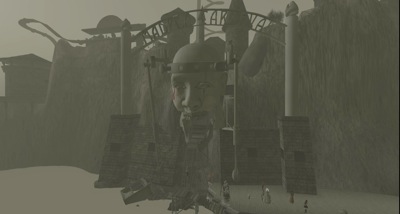
The inviting entrance
I wandered the midway, stopping at various attractions. I entered the fortune teller's area. She recited, "A handsome, mysterious stranger will enter your life this month. Kill him before he kills you." Now that's advice one wants to know ahead of time!
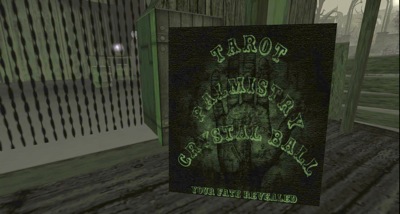
The fortune teller's booth
The fog-shrouded rides, like the midway games, are macabre and unsettling. The carousel has no animals; instead, riders hang from a meat hook.

The carousel
Below the surface, in an abandoned mine, is a racing game where one sits in a mine tram and pilots it around the twisty course.
Another puzzle involves a 1970s-decorated room - one needs to assemble the clues to find a way out!
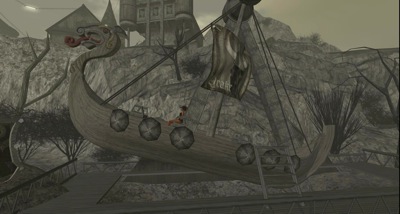
Another ride

The roller coaster and Ferris wheel
I have yet to explore the entire area, but what I've seen so far is creepy and oddly disturbing. (Plus, there are rides!) Well worth a visit.
The stale smell of the air and the nearly tangible sensation of despair will make you want to turn back before even entering.
Your throat feels tight and eyes are watering, trying their best to adjust to the dustiness. Deep inside you know already that death lurks around here, yet you're mesmerized and unable to run away. The calls of dancing souls have captured your mind and you feel the sudden urge to dive in to unite with them. What you don't realize is that, I am and you are, one of them already.
Full of frights and cloaked in shadows, the Carneval stands still, frozen in time. There are whispers and scaretales of its frightening adventures, haunted rides and unparalleled mysteries. Those who seek adventure are encouraged to step right up and prepare for an experience that will leave you begging for more.
Ladies and Gentlemen, welcome to the Madness.I approached the Carneval with some anxiety, having read about its Halloween opening from Miss Inara Pey. I was not alone: a number of people were standing idly around the landing point, and over 30 were in the sim.

The inviting entrance
I wandered the midway, stopping at various attractions. I entered the fortune teller's area. She recited, "A handsome, mysterious stranger will enter your life this month. Kill him before he kills you." Now that's advice one wants to know ahead of time!

The fortune teller's booth
The fog-shrouded rides, like the midway games, are macabre and unsettling. The carousel has no animals; instead, riders hang from a meat hook.

The carousel
Below the surface, in an abandoned mine, is a racing game where one sits in a mine tram and pilots it around the twisty course.
Another puzzle involves a 1970s-decorated room - one needs to assemble the clues to find a way out!

Another ride

The roller coaster and Ferris wheel
I have yet to explore the entire area, but what I've seen so far is creepy and oddly disturbing. (Plus, there are rides!) Well worth a visit.
Thursday, November 8, 2012
A Visit to the Old Country, Part 4
(Continues from Part 1, Part 2, and Part 3.)
We're almost done with the travelogue, so let's take a deep breath and continue to...
Friday morning was Southwark Cathedral and Boroughs Market. The latter is a sprawling complex of stands that sold everything from cheese to fresh meat, fish, and vegetables, to prepared foods, such as savory pies, and the place smelled great. I had to leave before lunch was moved up to 10:30 a.m.

Southwark cathedral
Past the replica of the Golden Hind, past the replica of the Globe Theater, crossing the Thames at the Millennium Bridge - which no longer shakes - in front of St. Paul's, we decided it was time for a restorative drink at Blackfriar's pub.
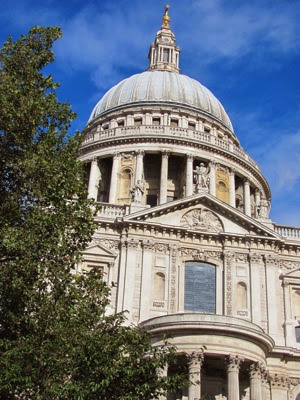
St. Paul's church
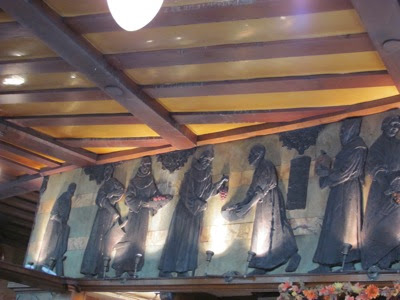
Black friars at Blackfrriar's pub
Next stop was the Temple Church, in the legal center of London. Founded by the Templar Knights, the church is now the responsibility of the four Inns of Court. Small church, with a round end opposite the altar, and dates to the Crusades.

Temple church
I firmly approve of the idea of making the legal profession pay for the upkeep of the church.
At the Twinings store, buying yet more tea, I could hear a noisy demonstration. Across the street was a court building (I think) and, in front of it, were a dozen loud people. The leader, shamefully enough, had an American accent. They were protesting the decision to extradite a terrorist being held in Britain to the U.S., ostensibly because the U.S. has the death penalty. The newspapers suggested that a majority of Britons preferred to have such a person in a different country, death penalty or no.
Friday evenings the British Museum is open late, and the crowds are relatively small.

Lewis chessmen

The Rosetta Stone
Canterbury was Saturday's trip, out a high-speed rail line. Although the town was quite crowded, the cathedral, thankfully, was not.

Canterbury cathedral

Stained glass windows inside the cathedral

Canterbury Palace

Ruins of the old cathedral
Nearby were the ruins of Canterbury Palace and St. Mildred's church. Then it was a long trek past the ring road to see St. Augustine's Abbey, which was torn down and converted into a huge Norman church after 1066.
By Sunday we were worn down and decided on a trip to the Victoria and Albert museum in Kensington. Between the museum and Harrod's was a small, curving street where, in a single block, a Ferrari, a Lamborghini, and a convertible Bentley coupe were parked. I'm not sure I would want to park my Lamborghini on the street, but, then again, I can't afford to live in that neighborhood.
Monday was devoted to shopping in town. Tuesday morning, bright and early, the trek back to the Colonies started.
We're almost done with the travelogue, so let's take a deep breath and continue to...
Friday morning was Southwark Cathedral and Boroughs Market. The latter is a sprawling complex of stands that sold everything from cheese to fresh meat, fish, and vegetables, to prepared foods, such as savory pies, and the place smelled great. I had to leave before lunch was moved up to 10:30 a.m.

Southwark cathedral
Past the replica of the Golden Hind, past the replica of the Globe Theater, crossing the Thames at the Millennium Bridge - which no longer shakes - in front of St. Paul's, we decided it was time for a restorative drink at Blackfriar's pub.

St. Paul's church

Black friars at Blackfrriar's pub
Next stop was the Temple Church, in the legal center of London. Founded by the Templar Knights, the church is now the responsibility of the four Inns of Court. Small church, with a round end opposite the altar, and dates to the Crusades.

Temple church
I firmly approve of the idea of making the legal profession pay for the upkeep of the church.
At the Twinings store, buying yet more tea, I could hear a noisy demonstration. Across the street was a court building (I think) and, in front of it, were a dozen loud people. The leader, shamefully enough, had an American accent. They were protesting the decision to extradite a terrorist being held in Britain to the U.S., ostensibly because the U.S. has the death penalty. The newspapers suggested that a majority of Britons preferred to have such a person in a different country, death penalty or no.
Friday evenings the British Museum is open late, and the crowds are relatively small.

Lewis chessmen

The Rosetta Stone
Canterbury was Saturday's trip, out a high-speed rail line. Although the town was quite crowded, the cathedral, thankfully, was not.

Canterbury cathedral

Stained glass windows inside the cathedral

Canterbury Palace

Ruins of the old cathedral
Nearby were the ruins of Canterbury Palace and St. Mildred's church. Then it was a long trek past the ring road to see St. Augustine's Abbey, which was torn down and converted into a huge Norman church after 1066.
By Sunday we were worn down and decided on a trip to the Victoria and Albert museum in Kensington. Between the museum and Harrod's was a small, curving street where, in a single block, a Ferrari, a Lamborghini, and a convertible Bentley coupe were parked. I'm not sure I would want to park my Lamborghini on the street, but, then again, I can't afford to live in that neighborhood.
Monday was devoted to shopping in town. Tuesday morning, bright and early, the trek back to the Colonies started.
Tuesday, November 6, 2012
Review: The Night Circus, by Erin Morgenstern
I seem to find myself drawn to books set in Victorian times. I'm also drawn to books in which magic features prominently. The Night Circus, a book set in Victorian times in which magic features prominently seemed right up my alley, and, indeed, it was.
At its heart, however, The Night Circus is a love story. Celia and Marco are each participants in a game involving magic. The two do not know the rules are not known; they do not know their opponents; they do not even know what constitutes. Each is raised by a cruel guardian. Under the direction of her father, Celia learns magic, particularly the ability to create, destroy, and re-create objects. Her father repeatedly slices open her fingers so she can learn to repair them. She becomes involved with developing a circus, the Cirque des Reves, and is the circus's illusionist - except the illusions are, in fact, real. Marco, an orphan, is adopted by a man who teaches him magic and arranges for him to be apprenticed to the man behind the finances of the circus. He is kept a virtual prisoner in his house in order to learn his skills. As the years go by, and the circus develops into a success that appears mysteriously in a town one night and disappears just as mysteriously after its run, it is clear that Celia and Marco have been weaving their magic into the circus itself.
Eventually the pair meet and, of course, fall in love against the advice of their guardians. Only one can survive, they are told - the game ends only when one player cannot go on.
The magic is as hard-won as that in Lev Grossman's The Magicians. (Both books are discussed on Episode 86 of The Incomparable! podcast.) While magic is integral to the plot, this a story about love and friendship, about unintended consequences, of free will versus carrying out the wishes of others. I enjoyed the book very much. The narrative is anything but straightforward, and the action moves slowly - indeed, years pass in the book - so The Night Circus may not be for everyone. But it hits the sweet spot of Victorian magicians in love.
At its heart, however, The Night Circus is a love story. Celia and Marco are each participants in a game involving magic. The two do not know the rules are not known; they do not know their opponents; they do not even know what constitutes. Each is raised by a cruel guardian. Under the direction of her father, Celia learns magic, particularly the ability to create, destroy, and re-create objects. Her father repeatedly slices open her fingers so she can learn to repair them. She becomes involved with developing a circus, the Cirque des Reves, and is the circus's illusionist - except the illusions are, in fact, real. Marco, an orphan, is adopted by a man who teaches him magic and arranges for him to be apprenticed to the man behind the finances of the circus. He is kept a virtual prisoner in his house in order to learn his skills. As the years go by, and the circus develops into a success that appears mysteriously in a town one night and disappears just as mysteriously after its run, it is clear that Celia and Marco have been weaving their magic into the circus itself.
Eventually the pair meet and, of course, fall in love against the advice of their guardians. Only one can survive, they are told - the game ends only when one player cannot go on.
The magic is as hard-won as that in Lev Grossman's The Magicians. (Both books are discussed on Episode 86 of The Incomparable! podcast.) While magic is integral to the plot, this a story about love and friendship, about unintended consequences, of free will versus carrying out the wishes of others. I enjoyed the book very much. The narrative is anything but straightforward, and the action moves slowly - indeed, years pass in the book - so The Night Circus may not be for everyone. But it hits the sweet spot of Victorian magicians in love.
Sunday, November 4, 2012
A Visit to the Old Country, Part 3
(Part 1 is here and Part 2 is here.)
The next day, Tuesday, was another in-town day, and the main stop was Westminster Abbey. We'd been there before, but this time around we took a verger tour. Our verger had a good sense of humor, bordering on the irreverent, which made the tour fun rather than dry.

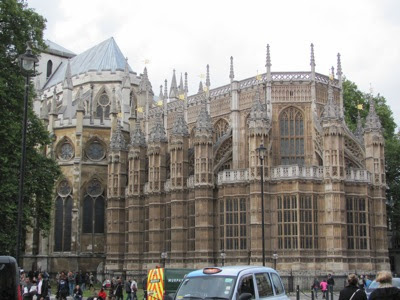
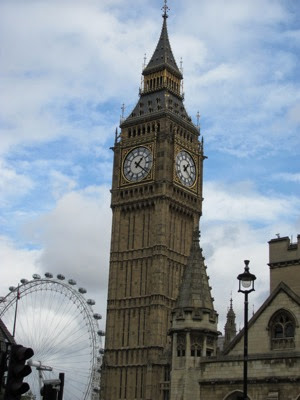
Before dinner we stopped at the bar at Duke's Hotel. Frequented by Ian Fleming in his day, the bar maintains the James Bond connection with a menu of drinks named after Bond characters. Drinks are prepared tableside: a bartender rolls out a cart containing the ingredients for the round of drinks. The liquor and glasses come straight from the freezer, so no ice is involved. He describes each ingredient before adding it to the mixing glass, stirs twice, and then pours the concoction into the frosted glass. An interesting process. Because of the lack of ice, the drinks are undiluted. As a consequence, the drinks are unbelievably strong. Well worth a stop, as long as your physician clears your liver for the ordeal.
Wednesday, Oct. 3, was an out-of-town day, this time to Winchester. (The reader will by now have sensed a cathedral-centric theme to this trip. Though, to be fair, I've spared the minor stops and most of the bars and pubs.)

The cathedral has a small library, and its claim to fame is a 12th-century illustrated bible, dubbed the Winchester Bible. The docents all seemed a little deprived of company, so we had a good chat with several of them.

For those Austen-ites out there, Winchester is also the burial place of Jane Austen:

Thursday was a break from the original plan to alternate days in London and train trips out of the city, necessitated by plans to go to the British Museum in the evening - Friday is the only day the museum is open late. Thus, Thursday saw us on the train to Oxford. It's a nice city, but it's no Caledon Oxbridge.

We dipped into the Ashmolean museum, leaving just before a massive school group arrived, wandered through Blackwell's massive book store, saw the Bodleian Library and Radcliffe Camera, only from the outside, alas.
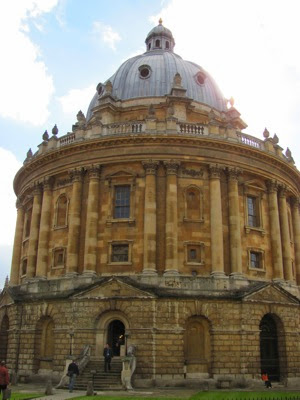

The "Bridge of sighs," connecting the old and new parts of Hertford College (and often seen in the Inspector Morse shows).
There's a marvelous shop in Oxford called Scriptum, filled with blank books in leather, inkwells, and reading- and writing-related antiques. I almost bought a half-dozen things, including a 1908 inkwell set and pen rest, but couldn't quite bring myself to spend 95 pounds.
The next day, Tuesday, was another in-town day, and the main stop was Westminster Abbey. We'd been there before, but this time around we took a verger tour. Our verger had a good sense of humor, bordering on the irreverent, which made the tour fun rather than dry.



Before dinner we stopped at the bar at Duke's Hotel. Frequented by Ian Fleming in his day, the bar maintains the James Bond connection with a menu of drinks named after Bond characters. Drinks are prepared tableside: a bartender rolls out a cart containing the ingredients for the round of drinks. The liquor and glasses come straight from the freezer, so no ice is involved. He describes each ingredient before adding it to the mixing glass, stirs twice, and then pours the concoction into the frosted glass. An interesting process. Because of the lack of ice, the drinks are undiluted. As a consequence, the drinks are unbelievably strong. Well worth a stop, as long as your physician clears your liver for the ordeal.
Wednesday, Oct. 3, was an out-of-town day, this time to Winchester. (The reader will by now have sensed a cathedral-centric theme to this trip. Though, to be fair, I've spared the minor stops and most of the bars and pubs.)

The cathedral has a small library, and its claim to fame is a 12th-century illustrated bible, dubbed the Winchester Bible. The docents all seemed a little deprived of company, so we had a good chat with several of them.

For those Austen-ites out there, Winchester is also the burial place of Jane Austen:

Thursday was a break from the original plan to alternate days in London and train trips out of the city, necessitated by plans to go to the British Museum in the evening - Friday is the only day the museum is open late. Thus, Thursday saw us on the train to Oxford. It's a nice city, but it's no Caledon Oxbridge.

We dipped into the Ashmolean museum, leaving just before a massive school group arrived, wandered through Blackwell's massive book store, saw the Bodleian Library and Radcliffe Camera, only from the outside, alas.


The "Bridge of sighs," connecting the old and new parts of Hertford College (and often seen in the Inspector Morse shows).
There's a marvelous shop in Oxford called Scriptum, filled with blank books in leather, inkwells, and reading- and writing-related antiques. I almost bought a half-dozen things, including a 1908 inkwell set and pen rest, but couldn't quite bring myself to spend 95 pounds.
Friday, November 2, 2012
Story Time Again
More 100 Word Stories from Crap Mariner at the Virtual Chelsea Hotel on Saturday.
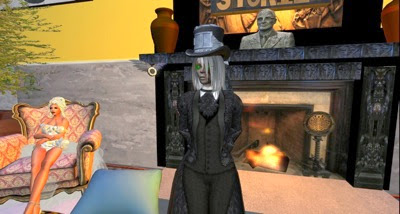
It was a big crowd, or so it seemed to me, with 11 people there for most or all of the hour, including Aquiel Aero, Bear, Brokali, Haley, Lizzie Gudkov, Lysander Spooner, Orchid Jameson, Queen Bluestar, and Shini, and a few more people arrived halfway through to hear Crap's stories.



It was a big crowd, or so it seemed to me, with 11 people there for most or all of the hour, including Aquiel Aero, Bear, Brokali, Haley, Lizzie Gudkov, Lysander Spooner, Orchid Jameson, Queen Bluestar, and Shini, and a few more people arrived halfway through to hear Crap's stories.


Subscribe to:
Posts (Atom)